You have some leftover Philadelphia cream cheese and no plans of using it anytime soon. Can you freeze Philadelphia cream cheese?
The good news is that you can freeze cream cheese. The bad news is that it changes its texture after defrosting and works well only in cooked and baked dishes.
For other uses, like spreading on bread or making cream cheese dips or spreads, using thawed Philadelphia is iffy.
Interested in learning the ins and outs of freezing Philadelphia cream cheese so that you know if freezing it makes sense in your circumstances?
If so, this article is for you. Read on.
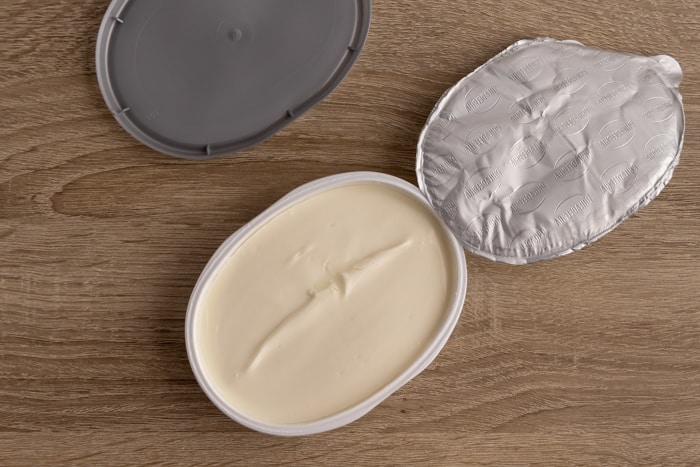
Can You Freeze Philadelphia Cream Cheese?
You can freeze Philadelphia cream cheese, but its texture changes after you defrost it. Instead of smooth and creamy, the cheese becomes noticeably thinner and somewhat chunky. Because of that, it works best in cooked and baked dishes.
The texture change is also why Philadelphia advise against freezing their cream cheese.
To give you a feel of how the texture change looks like, I made some photos.
Here’s Philadelphia cream cheese spread after freezing and defrosting:
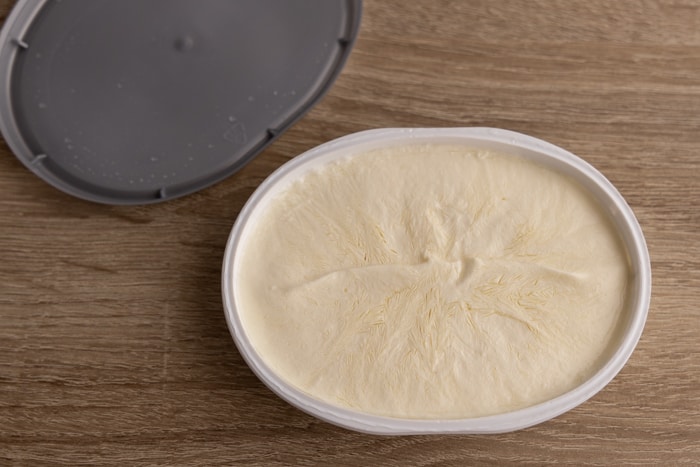
It doesn’t look that bad. There are only a couple of pockets of liquid visible on the surface, but there’s actually quite a lot of them (see photo later in the article).
But if you stir everything together to incorporate that liquid, here’s what you end up with:
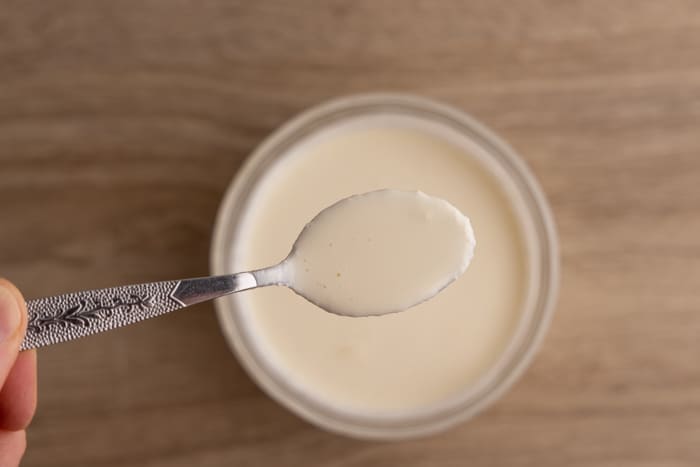
As you can tell, the cream cheese is yogurt-like (and not a thick one, mind you) in texture and is no longer smooth.
I tried eating defrosted Philadelphia spread with fresh fruit (photo later on), but it was pretty bad. I definitely don’t recommend eating it as-is after thawing.
You can remove all the separated liquid and make the cream cheese a bit thicker, but it’s still a far cry from a fresh one.
Fortunately, that texture alteration doesn’t mean that Philadelphia is useless after thawing. On the contrary, it’s still usable in most dishes that you cook or bake (I talk about specific examples of how to use frozen cream cheese later in the article).
That’s because, in those dishes, the texture of the cream cheese and whether or not it’s perfectly smooth don’t play such an important role. Or you can quickly fix those issues by adjusting the amounts of other ingredients.
Those are the basics. But before we get to the how-to section, let’s tackle a few specific issues you might be interested in.
Blocks vs. Spread
You might be wondering what are the differences between freezing Philadelphia spreads and blocks (or bricks). That’s understandable.
The Philadelphia cream cheese spread is much softer (and spreadable), while the blocks are more firm and difficult to spread.
Once frozen, the texture of both types changes. Since Philadelphia blocks have less moisture (which makes them firmer), that change isn’t as pronounced as in spreads. But it’s still there.
In other words, even if you’re going to freeze Philadelphia blocks, you’re still going to have to deal with some texture issues after defrosting. I give a few ideas on how to do that in a later section.
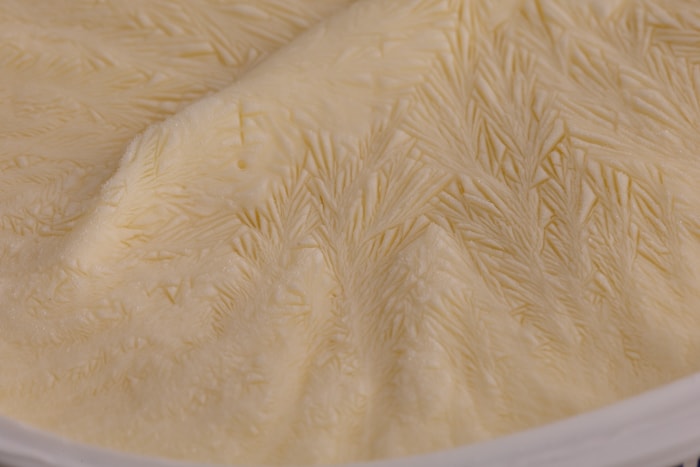
Philadelphia Cheesecake Filling
Freezing Philadelphia cheesecake filling isn’t a good idea. Like with the cream cheese itself, the texture of the filling changes after defrosting.
Because of that, you’re going to either:
- end up with a filling that’s too thin, if you just bake the cheesecake using the stirred defrosted filling, or
- work on fixing the texture of the filling before you bake that cheesecake
In other words, the thawed Philadelphia cheesecake filling requires some extra work before you can use it, assuming you care about the quality of the cake.
A better way to go about this is to bake that cheesecake and freeze it after it cools down. This way, you don’t have to deal with the mentioned texture issues.
If you can’t bake that cake right now because you’re missing some ingredients or don’t have the time, that filling can sit in the fridge for 2 to 3 days. That should give you enough time to buy those crackers or find the time need for baking.
If you really want to make freezing Philadelphia filling work, feel free to give it a go. You might need a couple of tries to nail fixing the texture issues after defrosting, but you should be able to make it work.

Philadelphia Cream Cheese Dips and Spreads
Freezing Philadelphia cream cheese dips and custom spreads is a bad idea. Both are usually made using Philadelphia spreads, and as you’ve already seen, spreads end up runny after defrosting. And that’s how your dips and homemade spreads will be like after thawing.
If you’re keen on making this work, you can try freezing a small amount of your favorite homemade dip or spread, and see how things go.
But before you put the container in the freezer, make sure the dip has as little water as possible (i.e., remove any extra moisture). And remove all the liquid that separated after thawing before you stir it.
Both will help the texture a bit, but don’t expect miracles.
If your dip isn’t good enough to eat after that treatment, assume it doesn’t freeze well and move on.
How To Freeze Philadelphia Cream Cheese
Here’s how you freeze cream cheese:
- Plan how you’re going to use it. Cream cheese freezes solid, so you cannot defrost a half or a third of the frozen portion. Because of that, consider how you will use the cream cheese after thawing and what portion size works best for your needs.
- Portion accordingly into airtight containers. Now that you have a plan in place, all you need to do is to transfer the portions into airtight containers. The containers that Philadelphia spreads come in work great for this purpose – no need to repackage if you freeze the whole thing. If you want to freeze an unopened cream cheese container, that’s also an option. For Philadelphia blocks, place them in containers (without the wrapping), even if you freeze whole bricks.
- Freeze. Label the containers with name and date if needed.
That’s it. The process is simple and takes a couple of minutes tops.
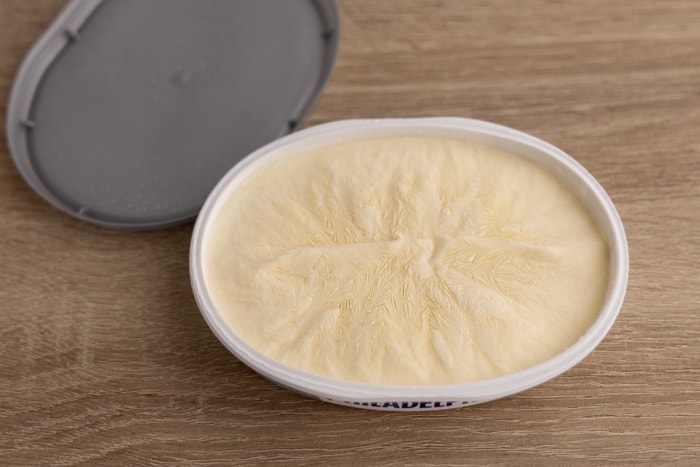
How Long Does Philadelphia Cream Cheese Last in the Freezer?
Try to defrost and use frozen Philadelphia cream cheese within 2 to 3 months for the best quality.
Like all other foods, the longer the cream cheese sits in the freezer, the lower its quality. And since soft cheeses aren’t known for their ability to withstand freezing temperatures, 2 to 3 months seems like a reasonable period.
Of course, nothing bad will happen if you leave the cream cheese in the freezer for an extra month or two. Its quality might be a bit worse, but that’s about it. If you use it in some delicious pancakes, you’ll hardly notice.
If you were wondering, I give a similar recommendation for other high-water-content dairy products, such as greek yogurt or ricotta cheese.
How To Thaw Frozen Philadelphia Cream Cheese
Defrost Philadelphia cream cheese in the freezer, using the containers you froze them in. The whole process takes between 4 to 12 hours, depending on the amount of cream cheese you’re defrosting.
To speed things up a bit, you can place the container in a bowl of lukewarm water (still in the fridge). This trick works because water conducts heat faster than air, and you can use it when defrosting any food product.
If it’s not a giant portion of Philadelphia, it’s enough to transfer it into the refrigerator in the evening so that it defrosts overnight and is ready in the morning. Or do that first thing in the morning so that it’s ready in the late afternoon.
Once the cheese is defrosted, it’s time to deal with the separated liquid.
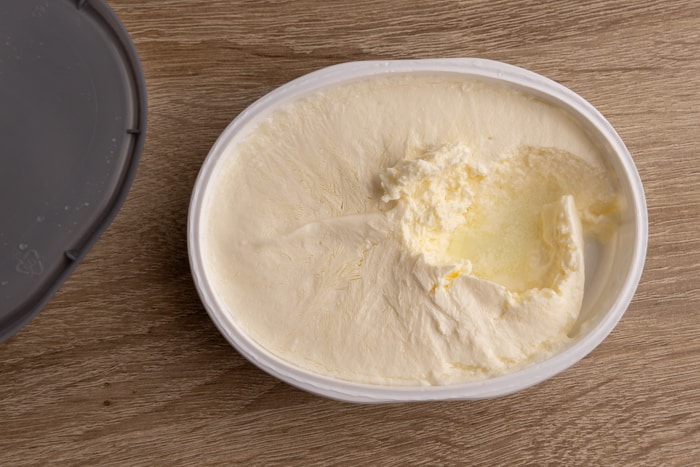
Again, there are two options here.
If soft and runny cream cheese is what you’re after (see photo earlier in the article), stir in the liquid. If not, strain as much of it as you can. When in doubt, go with the latter.
Once done, you’re ready to use your defrosted cream cheese.
Using Defrosted Philadelphia Cream Cheese
The most popular cooked and baked dishes with Philadelphia cream cheese include:
- filling in cheesecakes and other baked goods (note that defrosted cream cheese won’t work well in a topping)
- pancakes
- casseroles
- omelettes, frittatas, and the like
No matter which option you go with, pay attention to texture where it matters.
For example, when you’re prepping pancake batter, its texture is important. If it’s too thin, the resulting pancakes won’t be nice and fluffy.
And if you’re using thawed Philadelphia instead of a fresh one, that texture will be thinner than usual, all else being the same. And that’s when you might need to step in to fix that.
In the mentioned pancake batter example, the fix might be as simple as adding an extra teaspoon of flour to even things out. For other dishes, it’s your job to figure out a solution.
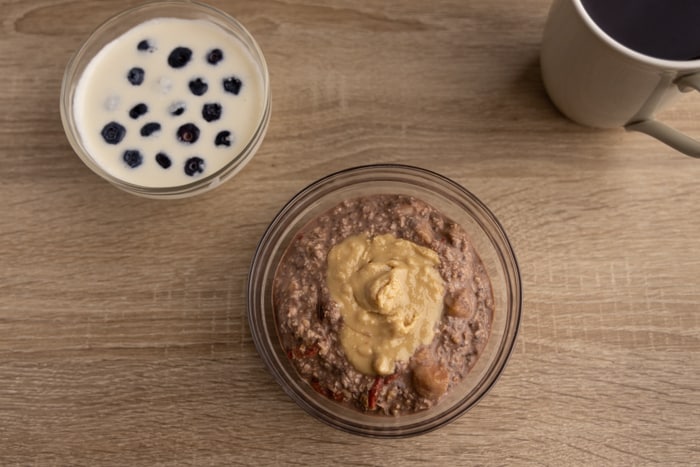
That said, sometimes the fact that the texture is a bit more runny isn’t an issue at all. And that’s the ideal situation because you don’t have to change anything in the recipe to make it work.
To know which dish requires fixing the texture and which doesn’t, it helps to know its ins and outs.
That’s why I suggest that when you use defrosted cream cheese, you should use it in a recipe you’re familiar with. Or, if this is the first time you use the recipe, make sure you’re at least well acquainted with the type of dish you’re cooking (like pancakes).